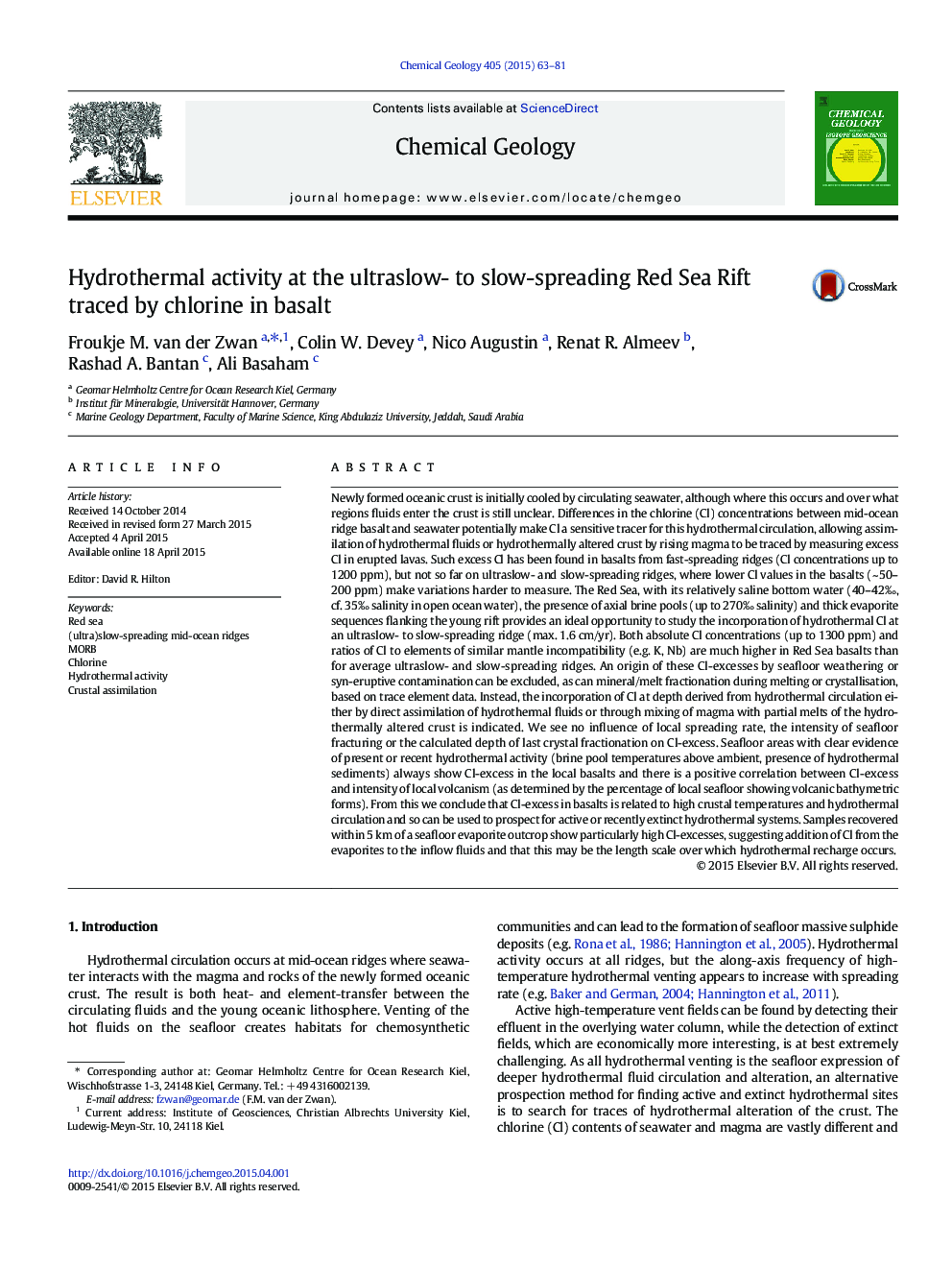| کد مقاله | کد نشریه | سال انتشار | مقاله انگلیسی | نسخه تمام متن |
|---|---|---|---|---|
| 4698537 | 1637568 | 2015 | 19 صفحه PDF | دانلود رایگان |
• Magmatic chlorine-excess is a highly sensitive tracer of hydrothermal contamination.
• Red Sea magmas show Cl-excess more extreme than even fast-spreading ridges.
• High-Cl Red Sea environment produces high-Cl hydrothermally altered crust and magmatic Cl-excess.
• (Ultra)slow-spreading ridge magmas can assimilate hydrothermally altered crust.
• Magmatic Cl-excess can guide hydrothermal prospection in the Red Sea.
Newly formed oceanic crust is initially cooled by circulating seawater, although where this occurs and over what regions fluids enter the crust is still unclear. Differences in the chlorine (Cl) concentrations between mid-ocean ridge basalt and seawater potentially make Cl a sensitive tracer for this hydrothermal circulation, allowing assimilation of hydrothermal fluids or hydrothermally altered crust by rising magma to be traced by measuring excess Cl in erupted lavas. Such excess Cl has been found in basalts from fast-spreading ridges (Cl concentrations up to 1200 ppm), but not so far on ultraslow- and slow-spreading ridges, where lower Cl values in the basalts (~ 50–200 ppm) make variations harder to measure. The Red Sea, with its relatively saline bottom water (40–42‰, cf. 35‰ salinity in open ocean water), the presence of axial brine pools (up to 270‰ salinity) and thick evaporite sequences flanking the young rift provides an ideal opportunity to study the incorporation of hydrothermal Cl at an ultraslow- to slow-spreading ridge (max. 1.6 cm/yr). Both absolute Cl concentrations (up to 1300 ppm) and ratios of Cl to elements of similar mantle incompatibility (e.g. K, Nb) are much higher in Red Sea basalts than for average ultraslow- and slow-spreading ridges. An origin of these Cl-excesses by seafloor weathering or syn-eruptive contamination can be excluded, as can mineral/melt fractionation during melting or crystallisation, based on trace element data. Instead, the incorporation of Cl at depth derived from hydrothermal circulation either by direct assimilation of hydrothermal fluids or through mixing of magma with partial melts of the hydrothermally altered crust is indicated. We see no influence of local spreading rate, the intensity of seafloor fracturing or the calculated depth of last crystal fractionation on Cl-excess. Seafloor areas with clear evidence of present or recent hydrothermal activity (brine pool temperatures above ambient, presence of hydrothermal sediments) always show Cl-excess in the local basalts and there is a positive correlation between Cl-excess and intensity of local volcanism (as determined by the percentage of local seafloor showing volcanic bathymetric forms). From this we conclude that Cl-excess in basalts is related to high crustal temperatures and hydrothermal circulation and so can be used to prospect for active or recently extinct hydrothermal systems. Samples recovered within 5 km of a seafloor evaporite outcrop show particularly high Cl-excesses, suggesting addition of Cl from the evaporites to the inflow fluids and that this may be the length scale over which hydrothermal recharge occurs.
Figure optionsDownload as PowerPoint slide
Journal: Chemical Geology - Volume 405, 5 June 2015, Pages 63–81
